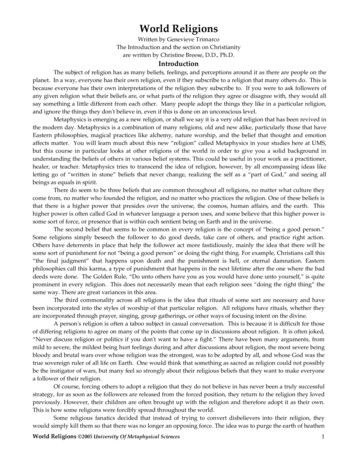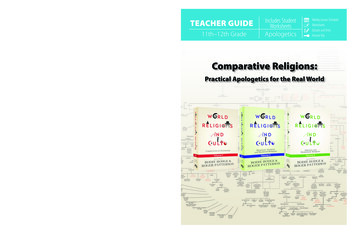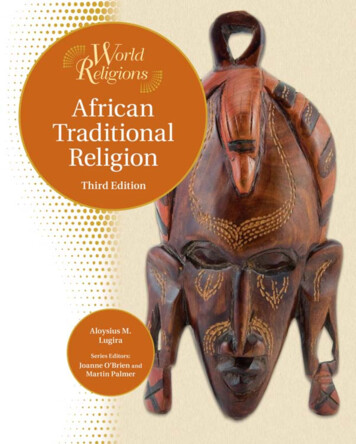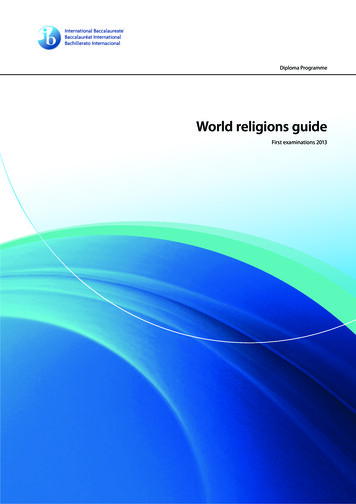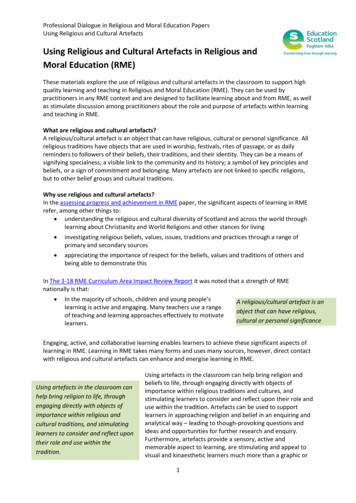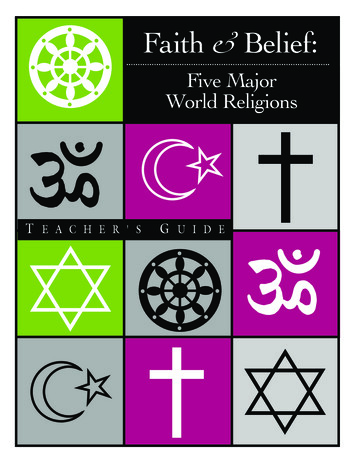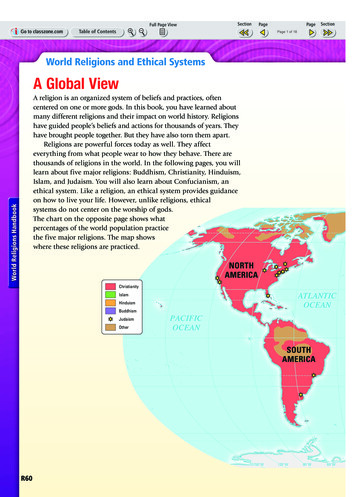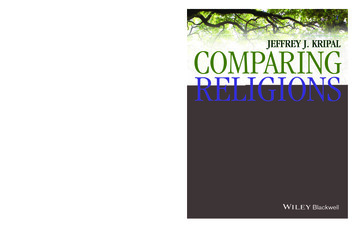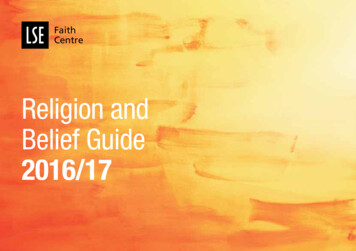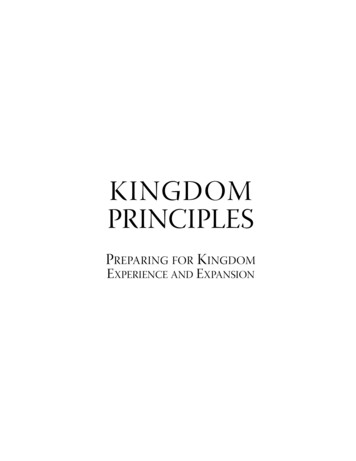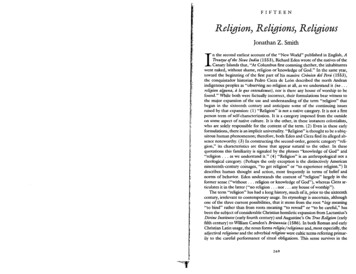
Transcription
FIfTEENReligion) Religions) ReligiousJonathan Z, Smithn the second earliest account of the "New World" published in English, ATreatyse of the Newe India (1553), Richard Eden wrote of the natives ofdleCanary Islands dut, .oAt Columbus first comming thether, the inhabitanteswent naked, without shame, religion or'knowledge of God," In the same year,toward the beginning of the first part of his massive Cn}',ica del Pent (1553),the conquistador historian Pedro Cieza de Leon described the north Andeanindigenous peoples as "observing no religion at all, as we understand it (no . .rcli.lfion algtma, d 10 que mtmdemos), nor is there any house of worship to befound." \Vhilc both were factually incorrect, their formulations bear witness tothe major expansion of the use and understanding of the term "religion" thatbegan in the sixteenth century and anticipate some of dle continuing issuesraised by that expansion: (I) "Religion" is not a native category. It is not a firstperson term of selt:characterization. It is a category imposed from the outsideon some aspect of native culture. It is the other, in these instances colonialists,who arc solely responsible for the content of the term. (2) Even in these earlyformulations, there is an implicit universality. "Religion" is thought to be a ubiquitous human phenomenon; therefore, both Eden and Cieza find its alleged absence noteworthy. (3) In constructing the second-order, generic category "religion," its characteristics arc those that appear natural to the odler. In thesequotations dlis familiarity is signaled by the phrases "knowledge of God" aJld"religion . as we understand it." (4) "Religion" is an anthropological not atheological category. (Perhaps the only exception is the distinctively Americannineteenth-century coinages, "to get religion" or "to experience religion.") Itdescribes human thought and action, most frequendy in terms of belief andnorms of behavior. Eden understands the content of "religion" largely in thefanner sense ("without . religion or knowledge of God"), whereas Cieza articulates it in the latter (Uno religion . nor . any house of worship").The term "religion" has had a long histol}', much of it, prior to the sixteenthcentury, irrelevant to contemporary usage. Its etymology is uncertain, althoughone of the three current possibilities, that it stems from dle root * leig meaning"to bind" rather than from roots meaning "to reread" or "to be careful," hasbeen the subject of considerable Christian homiletic expaJlsion from Lactantius'sDil,ine Imtittltes (early fourth century) and Augustine's On TrIte Religioll (earlyflfdl century) to William Camden's Britannia (1586). In both Roman and earlyChristian Latin usage, dle noun forms re!igio/ religiotIeS and, most especially, theadjectival re/igioStis and the adverbial religiose were cultic terms referring primarily to the careful performance of ritual obligations. This sense survives in theI269
JONATHAN Z. SMITHRELIGION, RELIGIONS, RELIGIOUSEnglish adverbial construction "religiously" designating a conscientious repetitive action such .15 "She reads the morning newspaper religiously." The onlydistinctively Christian usage was the fifth-century extension of this cultic senseto the totality of an individual's life in monasticism: "religion," a life bound bymonastic vows; "religious," a monk; "to enter religion," to join a monastery. Itis this technical \'ocabulary that is first extended to non-Christian examples inthe literature of exploration, particularly in descriptions of the complex civilizations of Mesoamerica. Thus Hernan Cortes, in his second Carta de Reiaei(m(1520, 64), writes ofTenochtitlan:recorded as "antiquities," to lise the term employed by Columbus. They raisedno particular issllcs for thought. But ritual, especially when it seemed similar toChristian practice or when it illustrated categories of otherness such as "idolatry" or "cannibalism," gave rise to projects of comparative and critical inquiries.Similarity and dificrence, witll respect to ritual, constituted a puzzle that required explanation by appeals to old patristic, apologetic charges of priestlydeccit or to equally apologetic, patristic theories of accommodation, demonicplagiarism, ditlusion, or degeneration. In the case of belief and myth, "their"words were primary; Witll ritual, "our" account superseded theirs.Some two centuries later, this essentially Camolic understanding of "religion" in dose proximity to ritual has been decisively altered. Samuel Johnson, inhis Dictiollm-y oftbe Eltglish Langtlage (1755), defines "religion" as "virtue, asfounded upon reverence of God, and expectations offuture rewards and punishments." The first edition of tile Ellcyclopaedia Brita1mica (1771) titled its entry"Religion, or Theology," defining the topic in the opening paragraph: "Toknow God, and to render him a reasonable service, arc the two principal objectsof religion, . Man appears to be formed to adore, but not to comprehend, tileSupreme Being." Terms such as "reverence," "service," "adore," and "worship" in these sorts of definitions have been all but evacuated of ritual connotations, and seem more to denote a state of mind, a transition begun by Reformation figures such as Zwingli and Calvin who understood "religion" primarily as"piety." The latter term takes on a less awesome cast in subsequent Protestantdiscourse, for example, "Piety, a Moral vertue which causes us to have atlcctionand esteem for God and Holy Things" (Phillips 1696),This shift to belief as the defining characteristic of religion (stressed in theGerman prcference tor the term Glatlbe over Religi011, and in me incrcasingEnglish usage of "faiths" as a synonym for "religions") raised a host of interrelatedquestions as to credibility and truth. These issues were exacerbated by the schismatic tendcncies of the various Protestantisms, with their rival claims to authority, as well as by the growing awareness of the existence of a multitude of articulate, non-Christian traditions. The former is best illustrated by the first attemptto provide a distribution map for the various European Protestantisms: EphraimPagitt's ChristianIJgraphie, or TIle Description of the Multittlde a1td SU1ldry Sortsof Christians in the World Not Sttbject to tile Pope (1635), The latter is the explicitsubject of the anthropological work by Edward Brerewood, Enqtliries TouchingThis great city contains many mosques [mezqztitas, an eleventh century Spanish loan word from the Arabic, masjidj, or houses toridols . The principal ones house persons of their religious orders(personas reitlTiIJsas de Stt secta) . . ,All these monks (reiigiosos) dressin black . from the time they enter the order (ent1'lJ1t e1I la J'eligilm).Cortes's relatively thoughtless language of assimilation is raised to the level of asystemic category two generations later in the encyclopedic work of tile Jesuitscholar Joseph de Acosta, The Natural and Moral History IJf tbe IlIdies (1590;English translation, 1604). While the vast majority of tile occurrences of theterm "religious" refer to either Catholic or native members of "religious orders," sometimes expanded to the dual category, "priests and monks of Mexico"(los sacerdotcs J rcli.lTiosos de Mexico), a number of passages strain toward a moregeneric conception. The work is divided into two parts, with the latter, "moralhistory," chiefly devoted to religion, governance, and political history. "Religion" per se is never defined. Its meaning must be sought in words associatedwith it as well as its synonyms, For Acosta, "religion" is the belief system thatresults in ceremonial behavior. "Religion" is "that which is used (que IlS1m) intheir rites." "Custom" (costtmtbre), "superstition" (supersticion), and "religion" (rdi.lTiim) form a belief series in conjunction with the action series of"deed" (hecho), "rite" (rito), "idolatry" (idolatria), "sacrifice" (sacrificio),"ceremony" (ceremonia), and "feasts" (fiestas y solemllidades)."Religion" in relation to ritual practice became an item in an inventory ofcultural topics that could be presented either ethnographically in terms of a particular people, as in Eden or Cieza with reference to the "Indies," or in a crosscultural encyclopedia under the heading of "ritual" or "religion." The encyclopedic version is illustrated by Joannes Boemus's popular 01lwitlm gentiummores, leges et ritus (1520), in which ritus was translated as "customs" in theEnglish translations by William Watrcman, 11,e Fardle of Faci(ms, COllteini1tg the ,,",:I '.the DiJ'ersity of Lallgltages and Religions throltgh the Chieft Parts of the Uflrldunintended consequence. The myths and beliefs of other folk could simply be(1614), which distinguished four "sorts" (i.e., "species") of the genus "religion"-"Christianity, Mohametanism, Judaism and Idolatry"-and providedstatistical estimates for "the quantitie and proportion of the pans of the earthpossessed by the several sorts" (1IB-19).lt is the qucstion of the plural religions(both Christian and non-Christian) that forced a new interest in the singular,generic religion. To cite what is perhaps the first widely rcad English book toemploy the plural in its title, Ptlrchas His Pil!frimage; or, Relations of the World270271Atmcimte J,[mmers, ClIstomes altd Lawes of the People Inhabitillg the Two Partesof the Earth (1555) and by Edward Aston, 11Je Manners, Lall's and Cllstoms ofall Natiolls (1611), and by Sebastian Muenster's Cosmographiae Imiversalis . . :Item (mmillmgC71tium mores, leges, religio (1550). This focus on ritual had an
JONATHANZ. SMITHand the RdilliollS ObscrJ'cd ill All Ages and Places Discm'ercd, "The true Religioncan be but one, and that which God himse1fe teacheth[,] . all other religionsbeing but strayings from him, whereby men wander in the darke, and in labvrinthine errour" (Purchas 1613, sig. D4r). What is implicit in Purchas bec mesexplicit in later seventeenth- and eighteenth-century debates concerning "natural religion," a term that became common only in the latter half of the seventeenth century, beginning with works such as the one by the prolific Puritancontroversialist Richard Baxter, TIu Reas01lSoftIJe CIJristilw Religion (1667), intwo parts: "Of Natural Religion, or Godliness," and "Of Christianity, and Supernatural Religion." (Compare Baxter's earlier but congruent terminology, OfRELIGION. RELIGIONS, RELIGIOUS.1i.While Tindal acknow1cdges some relativity-"I do not mean by This that Allshou'd have equal Knowledge; but that All shou'd have what is sufficient for theCircumstances they are in" (p. 5 )-his usual explanation for variation is the historical institution and wiles of "priestcraft":Sm';'llT Fait", TImt It Is Not ()lI V Gradtlally btlt Specifically Distinct from AllC01ll1ll1J11 Fait" [1658)).As David Pailan (1994) has demonstrated, the notion of natural religion hasbeen employed in the literature "to designate at least cleven significantly different notions, some of which have significant sub-divisions" ranging from "religious beliefs and practices that arc based on rational understanding that allpeople allegedly can discover for themselves and can warrant by rational reflection" to "that which is held to be common to the different actual faiths that havebeen and arc present in the world." The former definition largely grew out ofintra-Christian sectarian disputation and relied primarily on processes of introspection; the latter arose from study of the "religions," and involved processesof comparison. The essentially anthropological project of describing natural religion privileged similarity, often expressed by claims of universality or innateness; the explanation of dillcrence was chiefly historical, whether it emphasizedprogressive or degenerative processes. This double enterprise had tile effect ofblurring the distinctions between questions of truth and questions of origins.For example, the title of Matthew Tindal's fairly pedestrian but widely readtreatise, published anonymously as Christianity As Old as the Creati01I; or, TheGflspd, a Republicatioll of tile Religion of Nature (1730; six printings by 1732,and the BritiJ-IJ Museum General Catalogue lists more than forty replies in theI 730s), contains early English uses of the terms "religion of nature" and "Christianity." Tindal argues:lief of tile Existence ofa God, and the Sense and Practice of those Duties, which result from the Knowledge, we, by our Reason, have ofHim and his Perfections; and ofourselves, and our own Imperfections;and of the Relations we stand in to him, and to our Fellow-Creatures;so tllat the Religioll of Nature takes in every Thing that is founded onthe Reason and the Nature of Things. (pp. 3-7,13)'J.Religion either docs not concern the Majority, as being incapable offorming a Judgement about it; or must carry such internal Marks ofits Truth, as Men of mean Capacity are able to discover; or else notwithstanding tile infinite Variety of Religions, All who do not understand the Original Languages their traditional Religions arc writtenin, which is all Mankind, a very few excepted, are alike bound in allPlaces to pin their Faitll on their Priests, and believe in Men, whohave an Interest to deceive them; and who have seldom lail'd to doso, when Occasion serves. (p. 232)In Tindal's self-description,He builds notlling on a Thing so uncertain as Traditioll, which dif:fers in most Countries; and of which, in all Countries, the Bulk ofMankind arc incapable of judging; but thinks he has laid down suchplain and evident Rules, as may enable Men of tile meanest Capacity,to distinguish between Religion, and Superstitioll. (p. iii)·If God, then, Irom tile Beginning gave Men a Religion[,] . he musth.we giv'n them likewise sufficient Means of knowing it . If Godnever intended Mankind shou' d at any Time be without Religion, orhave lalse Religions; and there be but One True Religion, which ALLhave been ever bound to believe, and profess[,] . All Men, at allTimes, must have had sufficient Means to discover whatever God design\1 they shou'd know and practice . [He] has giv'n them noother Means for this, but the usc of Reason . There was from the Beginning but One Tme Religion, which all Men might know was theirDuty to embrace . By [this] Natrlral Religio1l, I understand the Be-When Tindal argued on logical grounds, the presumption of the unity oftruth, that natural religion "differs not Irom RCI'ml'd, but in the manner of itsbeing communicated: The One being tile Internal, as the Other the ExternalRevelation" (p. 3) he signaled the beginning of the process of transposing "religion" from a supernatural to a natural history, from a theological to an anthropological category. This process was complete only when the distinctions between questions of truth and questions of origin were firmly established. Whilenot without predecessors, the emblem of this transposition is David Hume's essay 17" Natural History of Religion, written between 1749 and 1751 and firstpublished in his collection Fotlr Dissertatio1lS (1757).The question Hume sets out to answer in the Natural History is that of religion'S "origin in human nature." He begins by disposing of the innateness thesis. If "religion" is defined as "the belief of iJwisiblc, intelligent power," then,although widely distributed, it is not universal, nor is there commonality: "notwo nations, and scarce any two men, have ever agreed precisclr in the same272273
JONATHANZ.SMITHREJ.IGION, RELIGIONS, RELIGIOUS;sentiments." "Religion" fails the minimal requirements for innateness, that it be"absolutely universal in all nations and ages and has always a precise, determinateobject, which it inflexibly pursues." Therefore, "religion" is not "an originalinstinct or primary impression of nature," and "the first religious principles mustbe secondary." In addition, because they arc "secondary," religious principles"may easily be perverted by various accidents and causes" (p. 25). In this opening move, a major thesis is forecast. There may well be a primary and valid humanexperience that gives rise to the secondary religious interpretation, but the truthofthe experience is no guarantee of the validity of the interpretation.The rich details ofHume's exposition need not concern us here but only theargument with respect to this issue. "Polytheism or idolatry was . the firstand most antient religion of mankind." Its origin must be sought in "the ordinary affections of human lite." Filled with anxiety, human beings seck the "unknown causes" that "become the constant object of our hope and fear." Theprimary human experience, "hope and fear," becomes a secondary religious interpretation when these "unknown causes" arc personified through "imagination" (pp. 26, 31-33).;What Hume here raises is dIe issue of the adjectival torm "religious." Whatsort of primary human experience or activity does it modify? What constitutes itsdistinctive secondary interpretation? How may religious interpretation be assessed in relation to other sorts of interpretation of the same experience or acth'ity? The "religious" (the unknown that the scholar is seeking to classify andexplain) becomes an aspect of some other human phenomenon (the known). AsWalter Capps (1995, 9) has argued, in the eighteenth-century Enlightenmentdebates "the goal of the inquiry was to make religion intelligible by discoveringprecisely where it is situated within the wide range of interactive human powersand faculties." In which of the genera of common individual human capacities isdle religious a species? Most frequently, the religious is identified with rationality, morality, or feeling.A different set of taxonomic questions were raised by tile "religions" and became urgent by the nineteenth century: Arc the diverse "religions" species of ageneric "religion"? Is "religion" the unique beginner, a lIIm11mmgmlls, or is itbest conceived as a subordinate cultural taxon? How might the several "religions" be classified?The question of the "religions" arose in response to an explosion of data.Increased mastel)' of non-European languages led by the latter part of theeighteenth century to a series of translations and editions of religious texts. Missionaries, colonial ot11cials, and travelers contributed ethnographic descriptions.Encyclopedias of religions, lexica, and handbooks (the latter, frequently bearingthe title" Hist0l)' of Religions") were produced to organize these materials. Oneof dIe earliest handbooks, Historische-theolo qischc Bericht vom Umerschied derReligionen die Hellte ZII Tage a rtf Erdc1J sind, by dIe Lutheran scholar JohannHeinrich Ursin (1563), focused heavily on the various Christian denominations,establishing a pattern that holds to the present day: that the history of me major"religions" is best organized as sectarian histol)', thereby reproducing the apologetic patristic heresiological model. By the time ofBrerewood's Euglliries TOllehill,g tbe Diversity of Langllages and Religions (1614) this horizon had beenextended to require inclusion of not only Christian data but also Jewish, Muslim, and "idolatl)'." This fourfold schema was continued by other writers fromthe seventeenth centul)' (for example, Guebhart Meier, Historia religi01ltmz,ChristiatJae, Jlldaeae, Gentilis, Malmmedanae [1697]) until well into the nineteenth century (Hannah Adams, A Dictionary ofAll Religions and ReltlJiolls De1lOmillatiolls, JelVish, Heatbm, Mahometall, alld Christial', A,zcient atld Modern[1817]; David Benedict, History of All Reltqiolls, As Divided ima Paganism,MaiJometism, jlldaism, and Christianity [ 1824 J; J. Newton Brown, EncyclopediaofReligiolfs KllOlI'le(qe: or, Dictionary . . Contl1i"ill,g Definitiom ofAll ReligiollsTerms; All Impartial Accolmt of the Principal Christia" Dmomillatiom thathave Existed in the Hbrld from the Birth of Christ to the Presmt Day with theirDoctrines, Reli,.qiotlS Rites atld Ceremonies, as lVell as those of the jelPs, Mohammedam, and Heathm Natiom, together lJIith the Mantlers and Customs of the East[1835b]; Vincent Milner, Religiolls Detlominatiom of the llilrld: Comprisitlg aGeneral View of the Origin, History and C01lditiOIJ of the Various Sects of Christiam, the jews, and Mabometans, As \%11 as tiJe Paga1' Forms ofReligion Existingin the Dijferetlt Countries of tbe Earth [1872 D. The bulk of the subsequent expansion occurred in Brerewood's fourth category, "Idolatry," with data addedon Asian religions and on those of traditional peoples. Beginning \vith AlexanderRoss, Pamebeia; or A View ofAll Religions ill the lWJrld from the Creation to TheseTimes (1614), there was a steady stream of reference works that undertook thistask, including Bernard Picart and J. F. Bernard, Ceremonies et cOlltumes de tOilSpe:lples d:1 monde (1723-43); Antoine Banier, Historic gbleral des cerbnonies,moellrs, et COlUmll/:S religieuses de tOilS les pellples du monde (1741); ThomasBroughton, An Historical Dietiollary of All Religions, from tbe Creatio" of the274275There is a universal tendency amongst mankind to conceive all beingslike themseh'es, and to transfer to e\'el)' object those qualities, withwhich they are f.1l1liliarly acquainted, and of which they arc intimatelyconscious. No wonder, then, that mankind, being placed in suchan absolute ignorance of causes, and being at the same time so anxious concerning their future fortunes, should immediately acknowledge a dependence on invisible powers, possest of sentiment andintelligence. The unknolPn callSes, which continually employ theirthought, appearing always in the same aspect, are all apprehended tobe of the same kind or species [as themselves]. Nor is it long beforewe ascribe to them thought, and reason, and passion, and sometimeseven the limbs and figures of men, in order to bring them nearer to aresemblance with ourselves. (pp. 33-34)I i
JONATHANZ.RF.LIGION, REI.IGIONS, Rt:LIGIOUSSMITHWorld to the Preswt Time (1742); Christopher Meiners, Grtmdriss der Gesell;e"te aller Re/ig;ollw (1785) and AIlgemei"e kritische Gesch;chte der Religi01lm(1806-7); John Bellemy, The History of All Religiom (1812); and BenjaminConst3nt, De la religion eomideree dans sa SOllree, ses formes et ses developpemmts(1824-31). This undertaking invented the familiar nomenclature, "Boudhism"(1821), "Hindooism" (1829, which replaced the earlier seventeenth-centuryusages "Gentoo [from "gentile"1 religion" and "Banian religion"), "Taouism"(1839), and "Confucianism" (1862). The urgent agendum was to bring orderto this variety of species. Only an adequate taxonomy would convert a "naturalhistory" of religion into a "science."The most common form of classifying religions, found both in native categories and in scholarly literature, is dualistic and can be reduced, regardless of whatditferentium is employed, to "theirs" and "ours." By the time of the fourthcentury Christian Latin apologists, a strong dual vocabulary was well in place andcould be deployed interchangeably regardless of the individual histories of theterms: "our religion'Y"their religion," with the latter often expressed throughgeneric terms such as "heathenism," "paganism," or "idolatry"; "true religion'Y"false religion"; "spiritual (or "internal") religion'Y"material (or "external") religion"; "monotheism" (although this term, itself, is a relatively late construction )/"polytheism"; "religion'j"superstition"; "rdigion'Y"magic." Thislanguage was transposed to intrareligious disputation with respect to heresies,and later revived in positive proposals of originary recovery in Christian Renaissance hermetism as well as, most massively and insistently, in Protestant polemicsagainst Roman Catllolicism. As such, it was at hand for tile evaluation of tilenewly encountered religions beginning in the sixteenth century. Lifting up tilefourfold enumeration of religions-Christianity, Judaism, Islam, and "Idolatry"-Christianity, in some imagination of its ideal form, became the norm inwhich Judaism and Islam problematically share. Adopting a term from Muslimdiscourse, these tllree "Abrahamic religions" form one set over and against anundifferentiated other:It is indeed probable, that all the idolatrous systems of religion,which have ever existed in the world, have had a common origin, andhave been modified by the different fancies and corruptions of different nations. The essence of idolatry is every where the same. It isevery where "abominable" in its principles and its rites, and everywhere the cause ofindescribablc and manifold wretchedness. (Brown1835a, 229)(as in "nature worship") and the placement ofiliese two terms in a chronologicalrelationship.,.\,'"The clements of nature were . the first divinities of man; he generally has commenced with adoring material beings. Everythingwas personified . Natural philosophers and poets [later distinguished] nature from herself-from her own peculiar energiesfrom her f.lculty of action. By degrees they made an incomprehensible being of this energy, which as bctixe tile), personified: thisabstract metaphysical being they called the mover of nature, or God.(Mirabaud 1770, 2: 4),I,.:.", I.j :.The initial problem tor a classification of the religions is the disaggregation oftllis category.One of the more persistent stratagems was the conversion of the epistemological duality natural/supernatural into a characterization of the object of belief276. ,':This simple schema of two religions could be greatly extended by the additionof intermediate stages in the temporal series.Nineteenth-century anthropological approaches focused on increasing menumber of "natural" religious categories, especially for "primitive" peoples,those held to be "nature peoples" (Nattlrvolker). Often mistermed evolutionary,these theories conceded no historical dimensions to those being classified butrather froze each ethnic unit at a particular "stage of development" of thetotality of human religious tllOught and activity. "Natural" religion was segmented into fetishism, totemism, shamanism, anthropomorphism, preanimism,animism, family gods, guardian spirits, ancestor worship, departmental gods, toname but a few. If the category "natural" were to be taken as including not only"primitives" but "antiquity," a set of peoples with whom tile scholar morereadily identified, then a meager note of historical dynamism would be introduced. For example, A. M. Fairbairn in his St"dies ill tile Philosophy of Religiona11d History (1876) divided "Spontaneous or Natural Religions" into twoclasses, "Primitive Naturalisms" (which included, among otllers, "primitives"and the "early" Greeks, Hindus, Teutons, and Slavs) and "Transformed Naturalisms" (e.g., "later" Greeks and Romans, Egyptians, and "ancient" Chinese).The "high religions," which could be designated "spiritual," required adifferent technique for tlleir division, one that recognized history. One proposal,establishing an alternative duality that remains current to this day, was set forthby the distinguished American Sanskritist, W. D. Whitney (1881,451): "Thereis no more marked distinction among religions than the one we are called uponto make between a race religion-which, like a language, is the collective product of the wisdom of a community, tile unconscious growth of generationsand a religion proceeding from an individual founder." He cites as examples ofthe latter, Zoroastrianism, "Mohammedanism," Buddhism, and Christianity,noting that tile latter may be described as "growing out of one [Judaism] thatwas limited to a race." Whitney here makes clear tile dilemma posed by tile studyof the "religions" from the perspective ofthe spiritual. The older fourfold enumeration of tile three "Abrahamic religions" plus "Idolatry" required revision .277
JONATHANZ.Judaism was to be demoted in that from .1 Christian apologetic perspcctivc, itwas the very type of a "fleshlr religion"; Buddhism was to be promoted becausein the two-century history of the Western imagination of Buddhism, it had become the very type of "spiritual religion."Fairbairn adjusted his model such that the ultimate duality was between"spontaneous or natural religions" and "instituted religions," with the latterhaving two classes, each characterized by the same powerfully positive Protestantterm: "Reformed Natural" (including the archaic religion of Israel ["Mosaism"]' Zoroastrianism, Confucianism, Taoism), and "Reformed Spiritual," limited only to the new triad (Buddhism, "Mohammedanism," and Christianity).All other "religions" fell into one of three classes of "natural," the repI.lCemelltteml for the older category, "idolatry."The most enduring device was the invention of the taxon "world" or "universal rcligions," a division that appeared to recognize both history and geography. The term was introduced and placed in a classificatory scheme that synthesized previous taxonomic divisions in a work that stands as the first classic in thescience of religion, Cornelius Petrus Tiele's work Olltli11e of tlJe History of Reli·gion to the Spread of U71iversal ReligiollS (1876), and was reworked in Tide'sarticle "Religions" in the ninth edition of the E7zeyciopaedia Britamzica (1884).Tiele's "morphological" classification, which schematizes the "stage of development" each religion has "attained," has as its fundamental principle of division"natura! religion" and "ethical religion," which he self-consciously correlateswith 'Whitney's distinction between "race religion" and "founded religion.""Natuml religion" has three families, one of which has two genera. The firstfamily comprises "polydaemonistic magical religions under the control of animism." To this class "belong [all] the religions of the so-called savages or uncivilized peoples." Recognizing, perhaps, the effects of colonialism, he addsthat their present forms arc "only degraded remnants of what they once musthave been."The second family of "nature religions" is
possessed by the several sorts" (1IB-19).lt is the qucstion of the plural religions (both Christian and non-Christian) that forced a new interest in the singular, generic religion. To cite what is perhaps the first widely rcad English book to employ the plural in its title, Ptlrchas His Pil
